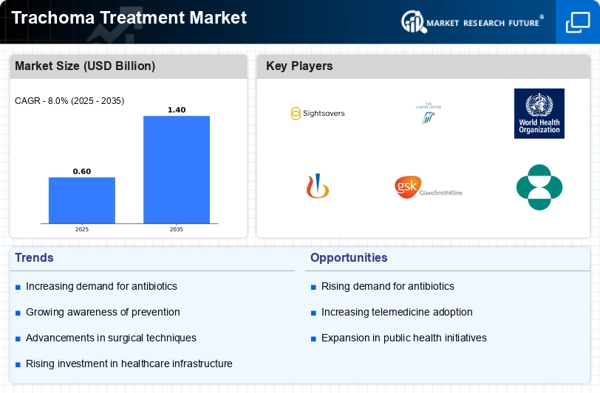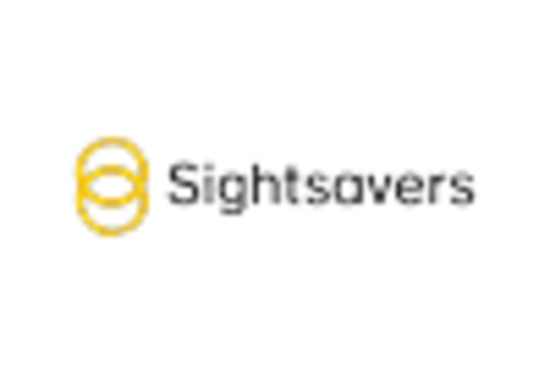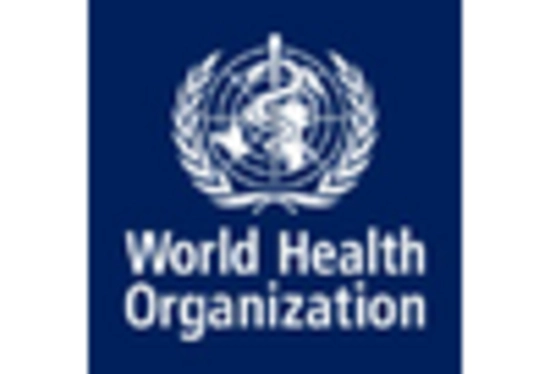Rising Prevalence of Trachoma
The increasing prevalence of trachoma, particularly in underdeveloped regions, is a primary driver of the Trachoma Treatment Market. According to the World Health Organization, trachoma remains a leading cause of preventable blindness, affecting millions worldwide. The burden of this disease is particularly pronounced in areas with limited access to clean water and sanitation. As awareness of the disease's impact grows, there is a corresponding rise in demand for effective treatment options. This trend is likely to stimulate investment in research and development, thereby enhancing the overall landscape of the Trachoma Treatment Market. Furthermore, the need for comprehensive treatment strategies, including surgery and antibiotic distribution, is becoming increasingly urgent, which may lead to a surge in market growth.
Government Initiatives and Funding
Government initiatives aimed at eradicating trachoma are significantly influencing the Trachoma Treatment Market. Various countries have implemented national programs to combat this disease, often supported by international funding and partnerships. For instance, initiatives such as the SAFE strategy (Surgery, Antibiotics, Facial cleanliness, and Environmental improvement) have been adopted in numerous regions. These programs not only provide financial resources but also facilitate the distribution of essential treatments and educational campaigns. The commitment of governments to allocate funds for trachoma eradication efforts is likely to enhance the accessibility of treatments, thereby driving growth in the Trachoma Treatment Market. As these initiatives gain momentum, the market may witness an increase in the availability of innovative treatment options.
Rising Awareness and Education Efforts
The growing emphasis on awareness and education regarding trachoma is significantly influencing the Trachoma Treatment Market. Educational campaigns aimed at informing communities about the causes, prevention, and treatment of trachoma are becoming increasingly prevalent. These initiatives are often spearheaded by health organizations and local governments, aiming to reduce the stigma associated with the disease and encourage individuals to seek treatment. As awareness increases, so does the likelihood of early diagnosis and intervention, which can lead to better health outcomes. This heightened awareness is expected to drive demand for treatment options, thereby contributing to the expansion of the Trachoma Treatment Market. Furthermore, as communities become more informed, the overall public health landscape may improve, further supporting market growth.
Technological Innovations in Treatment
Technological advancements are playing a crucial role in shaping the Trachoma Treatment Market. Innovations in medical technology, such as improved surgical techniques and the development of new antibiotic formulations, are enhancing treatment efficacy. For example, the introduction of minimally invasive surgical procedures has shown promise in reducing recovery times and improving patient outcomes. Additionally, advancements in telemedicine are facilitating remote consultations and follow-ups, which can be particularly beneficial in rural areas where access to healthcare is limited. These technological innovations not only improve the quality of care but also expand the reach of treatment options, potentially leading to increased market penetration in the Trachoma Treatment Market.
Increased Public and Private Partnerships
The rise of public and private partnerships is emerging as a significant driver in the Trachoma Treatment Market. Collaborations between governments, non-governmental organizations, and private sector entities are fostering a more coordinated approach to tackling trachoma. These partnerships often result in shared resources, expertise, and funding, which can enhance the effectiveness of treatment programs. For instance, joint initiatives may focus on community education, distribution of antibiotics, and surgical interventions. The synergy created through these collaborations is likely to lead to more comprehensive and sustainable solutions for trachoma treatment, thereby positively impacting the market landscape. As these partnerships continue to evolve, they may unlock new opportunities for growth within the Trachoma Treatment Market.


















Leave a Comment